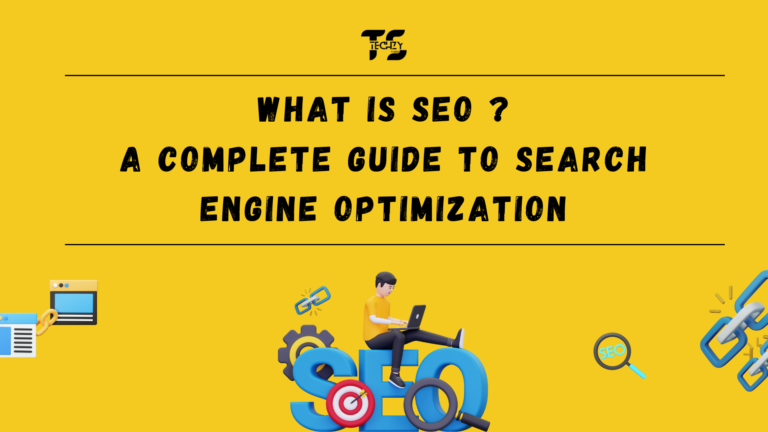What is SEO ? A Complete Guide To Search Engine Optimization
- Vaidik Radadiya
- January 24, 2024

I. What is SEO ?
Definition and purpose of SEO –
SEO, or Search Engine Optimization, is a set of techniques aimed at enhancing a website’s visibility on search engines like Google. Its purpose is to improve organic (non-paid) search rankings, driving more relevant traffic to a site. By optimizing content, keywords, and technical aspects, SEO increases a website’s chances of appearing prominently in search results. The ultimate goal is to boost online presence, attract target audiences, and maximize the site’s potential for higher traffic, engagement, and conversions.
Evolution of search engines
The evolution of search engines and SEO is marked by continual advancements in technology and user expectations. In the early days, search engines relied heavily on keyword density and meta tags. As internet usage grew, algorithms became more sophisticated, considering factors like backlinks and user experience. The advent of Google in the late 1990s revolutionized search with its PageRank algorithm, emphasizing quality content and relevance. Over time, updates like Panda, Penguin, and Hummingbird refined search algorithms, penalizing low-quality practices. Mobile optimization, voice search, and machine learning are now integral, reflecting a shift towards user-centric, context-aware search experiences, shaping the ongoing evolution of SEO and search engines.

II. Basics of SEO:-
1. How Search Engines Work:
– Crawling: Search engines use automated bots (spiders or crawlers) to browse and index web pages.
– Indexing: The crawled information is organized and stored in a vast database, creating an index of web pages.
– Ranking: Algorithms determine the relevance of indexed pages to specific search queries and rank them based on various factors.
2. Importance of Organic Search:
– Long-Term Visibility: Organic search results provide sustainable visibility over time without continuous ad spend.
– Credibility: Users often trust organic results more than paid ones, contributing to a positive brand image.
– Cost-Effectiveness: While SEO requires effort, the long-term benefits often outweigh the costs associated with paid advertising.
3. Difference Between Organic and Paid Search Results:
– Organic Search: Listings that appear naturally based on relevance to the search query, without direct payment to the search engine.
– Paid Search: Advertisers pay for their listings to appear at the top or bottom of search engine results for specific keywords.
4. Key SEO Terminology:
– Keywords: Words or phrases users type into search engines; optimizing content around relevant keywords is crucial.
– Backlinks: Links from external websites to your site; quality backlinks can improve a site’s authority and search rankings.
To check your website’s backlink visit here : Best backlink checker
– SERPs (Search Engine Results Pages): The pages displayed by search engines in response to a query, including organic and paid results.
– Meta Tags: HTML tags providing information about a web page; meta title and meta description impact how a page appears in search results.
– Alt Text: Descriptive text for images, improving accessibility and helping search engines understand the content.
– On-Page SEO: Optimizing elements on a webpage (content, HTML tags, etc.) to improve search visibility.
– Off-Page SEO: Actions taken outside a website to improve its online reputation, often through link building and social media.
– Algorithm: The set of rules or calculations search engines use to determine the relevance and ranking of web pages.
III. Importance of SEO:-

1. Enhanced Visibility and Organic Traffic:
– SEO improves a website’s visibility on search engines, increasing the likelihood of attracting organic (non-paid) traffic. Higher visibility ensures that the website is more easily found by users searching for relevant information.
2. Credibility and Trust-Building:
– Users tend to view websites that rank well in organic search results as more reliable and credible.. Establishing a strong organic presence contributes to building a positive online reputation.
3. Impact on User Experience:
– SEO involves optimizing elements such as site structure, content, and navigation, leading to an improved user experience. A user-friendly website not only satisfies visitors but is also favored by search engines, positively impacting rankings.
4. Cost-Effectiveness Compared to Paid Advertising:
– While paid advertising can deliver immediate results, it requires ongoing financial investment. SEO, on the other hand, offers long-term visibility without continuous ad spend. Over time, the cost-effectiveness of SEO often surpasses that of paid advertising.
5. Insights into Customer Behavior Through SEO Tools:
– SEO tools provide valuable data and analytics, offering insights into user behavior, preferences, and trends. By analyzing this data, businesses can make informed decisions, refine their strategies, and align their content with user expectations.
IV. Search Engine Algorithms:-
1.Understanding Search Engine Algorithms:
– Search engine algorithms are complex sets of rules and calculations that determine how search engines rank and display results. They consider various factors to deliver the most relevant and high-quality content to users based on their search queries.
2.Google’s PageRank and Algorithm Updates:
– PageRank: Introduced by Google founders Larry Page and Sergey Brin, PageRank evaluates the importance of web pages based on the quantity and quality of links pointing to them. Pages with more high-quality backlinks are deemed more authoritative.
– Algorithm Updates: Google regularly updates its algorithms to enhance search quality. Notable updates include Panda (2011, targeting low-quality content), Penguin (2012, addressing link spam), and Hummingbird (2013, focusing on semantic search and user intent).
3.The Role of AI and Machine Learning in Modern Algorithms:
– AI and Machine Learning: Modern search engine algorithms, including Google’s, increasingly incorporate AI and machine learning. These technologies enable algorithms to learn and adapt based on user behavior, improving the relevance of search results over time.
– RankBrain: Introduced by Google in 2015, RankBrain is a machine learning component that helps interpret and understand the meaning behind search queries. It refines search results by considering context and user intent.
– BERT (Bidirectional Encoder Representations from Transformers): Introduced in 2019, BERT enhances the understanding of the context of words in a search query, allowing search engines to provide more accurate and context-aware results.
– Neural Matching: Google’s algorithms employ neural matching to understand the relationships between words and phrases, helping to match search queries with relevant content even when the exact words may not be present.
4.Impact on SEO Strategy:
– Understanding these algorithms is crucial for SEO professionals. Strategies need to focus on providing high-quality, relevant content that aligns with user intent. Prioritizing user experience, natural language, and semantic context is key to optimizing for modern search engine algorithms.
V. Key Components of SEO
1.On-Page SEO: On-page SEO is the foundation of optimizing individual pages to rank higher in search results. Key elements include:
– Keyword Research: Identifying relevant keywords to target in your content.
– Content Optimization: Crafting high-quality, relevant, and engaging content.
– Meta Tags: Optimizing meta titles and descriptions to accurately represent page content.
– Headers and Structure: Organizing content with headers to enhance readability and SEO.
2.Off-Page SEO: Off-page SEO involves strategies beyond your website to enhance its authority. Key elements include:
– Link Building: Acquiring high-quality backlinks from reputable websites.
– Social Media Signals: Leveraging social media to promote content and increase brand visibility.
– Influencer Outreach: Collaborating with influencers to amplify your brand’s reach.
3.Technical SEO: Technical SEO focuses on the backend elements that impact a website’s crawlability and indexation. Key components include:
– Site Speed Optimization: Improving loading times for better user experience and search rankings.
– Mobile Responsiveness: Ensuring your site is accessible and functional across various devices.
– Crawl Errors and Sitemap: Rectifying crawl errors and creating a sitemap for efficient indexing.
4.Local SEO: Local SEO targets geographically specific audiences. Key elements include:
– Optimising your Google My Business listing: This involves claiming and improving your listing.
– Local Citations: ensuring that web directories provide accurate company information.
– Customer Reviews: Encouraging and managing customer reviews for improved local credibility.
5.Voice Search Optimization: With the rise of voice-activated devices, optimizing for voice search is crucial. Key considerations include:
– Natural Language Processing: Aligning content with conversational queries.
– Long-Tail Keywords: Targeting longer, more specific phrases that mirror voice search patterns.
6.E-commerce SEO: E-commerce websites have unique SEO needs. Key considerations include:
– Product Page Optimization: Crafting compelling product descriptions and titles.
– User Experience: Ensuring seamless navigation and a frictionless buying process.
– Structured Data Markup: Utilizing schema markup for enhanced search results.
7.Video SEO: Video content is gaining prominence. Key elements for video SEO include:
– Optimized Titles and Descriptions: Crafting descriptive and keyword-rich titles and descriptions.
– Video Transcripts: Providing transcripts for accessibility and improved understanding.
– Engagement Metrics: Monitoring metrics like watch time and click-through rate
VI. The Evolving Landscape of SEO:-
1. Machine Learning and AI in SEO:
– Algorithm Enhancement: Search engines, particularly Google, employ machine learning and AI to refine algorithms. RankBrain, BERT, and neural matching improve search result relevance by understanding user intent and context.
– Personalization: AI analyzes user behavior to personalize search results, making SEO strategies more nuanced and user-centric.
– Predictive Analytics: AI assists in predicting trends and user behavior, aiding SEO professionals in staying ahead of changes and optimizing strategies.
2. Mobile-First Indexing:
– Mobile Optimization: Search engines prioritize mobile-friendly websites for indexing and ranking.
– User Experience: Mobile-first indexing ensures a seamless user experience on smartphones and tablets.
– Responsive Design: Websites should have responsive design, adapting content to various screen sizes for optimal performance.
3. Core Web Vitals and User Experience:
– Loading Performance (LCP): Largest Contentful Paint measures the time it takes for the largest element on a page to load. Fast loading times improve user experience and SEO.
– Interactivity (FID): First Input Delay assesses the responsiveness of a page when a user interacts. A low FID enhances interactivity and user satisfaction.
– Visual Stability (CLS): Cumulative Layout Shift measures visual stability by assessing unexpected layout shifts. Minimizing CLS ensures a stable and user-friendly experience.
4. Voice Search Optimization:
– Rise of Voice Assistants: With the growing popularity of voice-activated devices, optimizing content for voice search is crucial.
– Natural Language Processing: Voice search relies on natural language processing, emphasizing conversational and long-tail keywords.
– Structured Data Markup: Implementing structured data helps search engines understand and present information in voice search results.
5. Video Content and SEO:
– Video Dominance: Video content continues to grow in popularity, influencing search engine rankings.
– Optimization: Video optimization includes using descriptive titles, captions, and transcripts for accessibility and improved search visibility.
– YouTube SEO: YouTube, as a search engine itself, demands optimized video content for better visibility within the platform and traditional search results.
6. Local SEO and Google My Business:
– Local Search Emphasis: Local SEO has gained prominence, with search engines prioritizing location-based results.
– Google My Business: Optimizing Google My Business profiles is crucial for local businesses to appear in local search results and Google Maps.
Check Benefits of SEO here : Benefits of SEO – SEO Superpowers
Conclusion:
In the dynamic world of the internet, where change is the only constant, mastering the art of SEO is an ongoing journey. From understanding the fundamentals and key components to implementing best practices and adapting to the evolving landscape, effective SEO requires a holistic approach. As websites continue to compete for digital real estate, the strategic deployment of SEO techniques remains the catalyst for sustained online success. Embrace the nuances, stay agile, and let SEO be the guiding force propelling your digital presence to new heights in the ever-expanding digital realm
4 thoughts on “What is SEO ? A Complete Guide To Search Engine Optimization”
Hi! This is my 1st comment here so I just wanted to give a quick shout out and tell you I truly enjoy reading your posts. Can you suggest any other blogs/websites/forums that deal with the same topics? Thank you so much!
Have you ever considered writing an e-book or guest authoring on other sites? I have a blog based upon on the same subjects you discuss and would love to have you share some stories/information. I know my subscribers would appreciate your work. If you’re even remotely interested, feel free to shoot me an e-mail.
Regards for all your efforts that you have put in this. very interesting information.
Pretty nice post. I just stumbled upon your weblog and wished to say that I’ve really enjoyed surfing around your blog posts. In any case I’ll be subscribing to your rss feed and I hope you write again very soon!